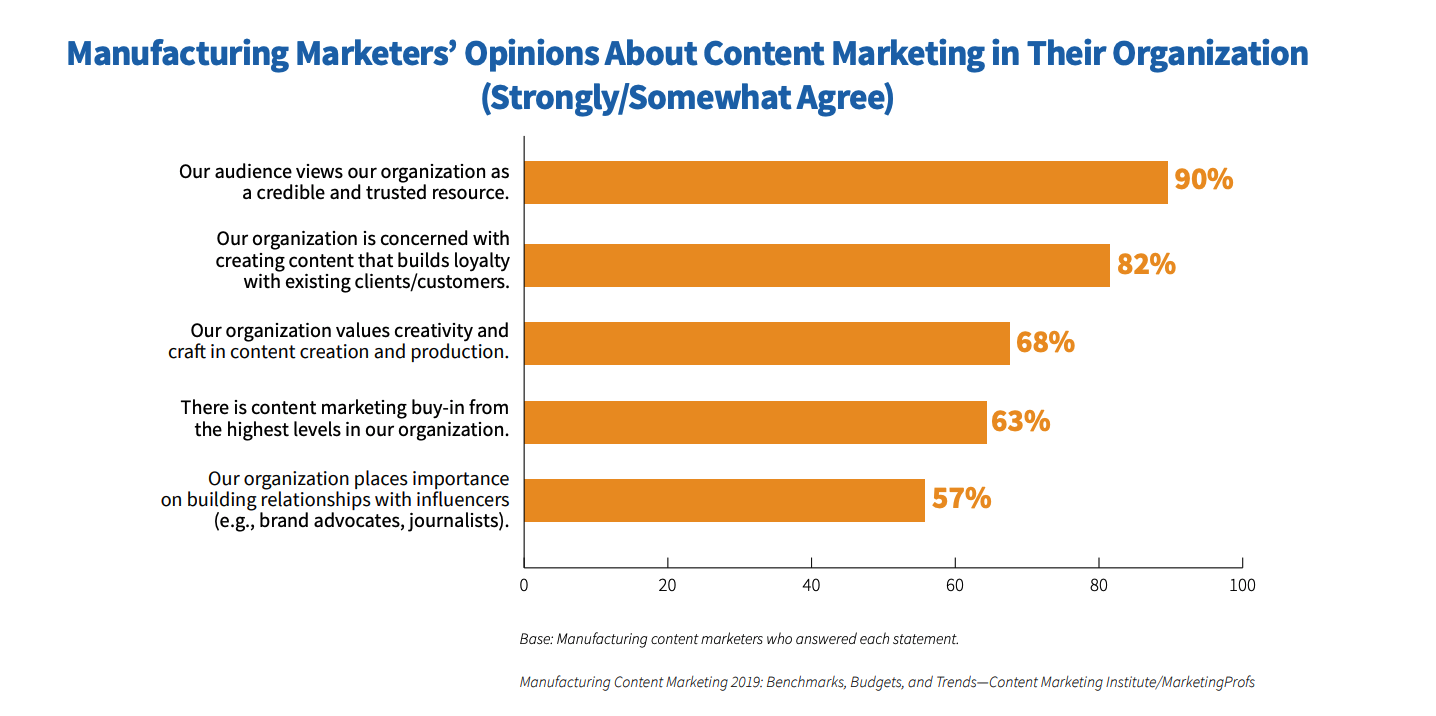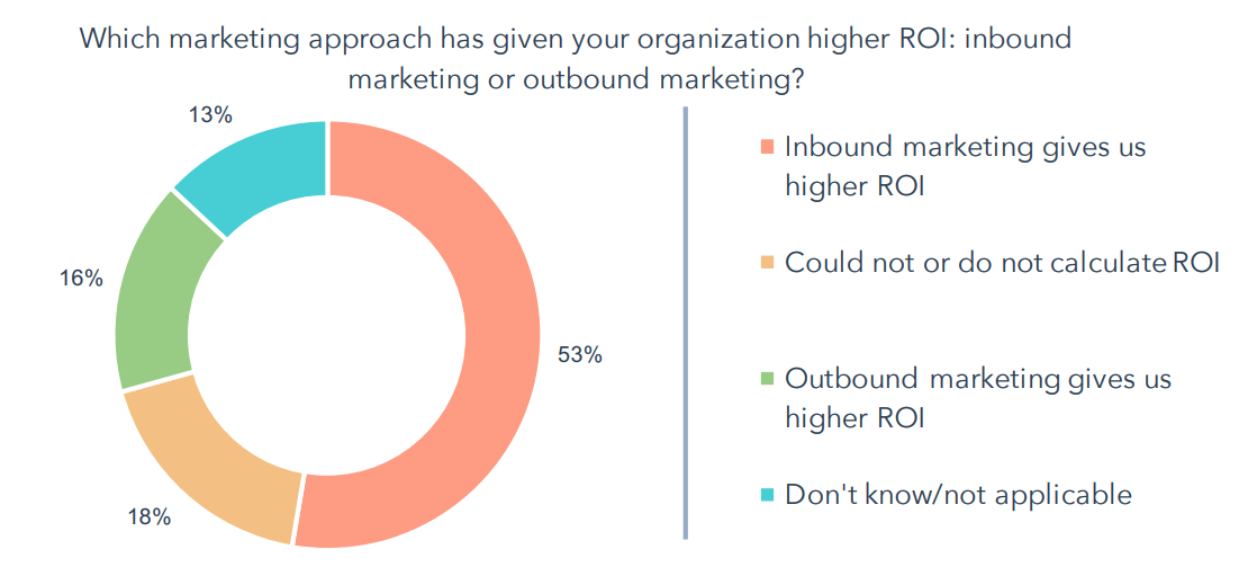Digital Marketing Strategy: 8 Markers of Success
Here are 8 markers of a digital marketing strategy manufacturers are finding success with:
1. They are Content Creators
In a 2019 research study of manufacturing companies, 67-percent rated overall content marketing success between moderately to hugely successful.
This same study found that success is likely to increase as a manufacturer's commitment to creating and publishing useful content for the market grows.
And, while 79-percent of respondents increased spending on content marketing in the last 12 months, the area of content creation saw the most significant boost in spending. Keep reading to discover the types of irresistible content we suggest.

Source: Manufacturing Content Marketing 2019: Benchmarks, Budgets and Trends, by the Content Marketing Institute and Marketing Profs
2. They Invest in Digital Tools & Technologies
Content without the infrastructure to channel and measure effectiveness is useless. Manufacturers committed to providing content understand that while the technologies are not what makes the difference, they are essential to content transmission and visibility.
Core tools and technologies include:
- A Content Management System (CMS) such as a dynamic vs. static website and blog, along with landing pages and calls-to-action for converting visitors into content subscribers and leads.
- Social Media Publishing Tools for engaging with prospective buyers.
- Audio/Visual Technologies to address how modern buyers tend to consume content and conduct research.
- Customer Relationship Management (CRM) is a software technology used for managing all of your company’s interactions with prospects and customers.
- Analytics Tools for measuring and improving success.
- Email/Marketing Automation Software for nurturing leads along the lines of their interests and buyer journey.
- Inbound/Digital Marketing Platform such as HubSpot which integrates many of the above content, sales, analytics, customer service, and CRM functions into one bundle.
An active digital marketing program uses software and systems to help keep things humming along. These may include workflow, project management, editorial calendars, and content optimization tools.
The depth and breadth of technologies can seem overwhelming. But there’s good news. Cloud-based all-in-one systems like HubSpot exist to integrate content functions without the steep cost of ownership, upgrades, and maintenance inherent in cobbling together disparate systems.
3. Everyone is a Content Contributor
 Successful organizations realize it’s not just the marketing department that’s responsible for identifying and creating content. Unleash the power of content with multiple department involvement.
Successful organizations realize it’s not just the marketing department that’s responsible for identifying and creating content. Unleash the power of content with multiple department involvement.
While it’s widely agreed (92-percent in one study) that content marketing buy-in is necessary from the highest levels of an organization, content planning, and execution is everyone’s game.
As we stated in 5 Ways Inbound Marketing will Work for Your Manufacturing Company, it’s imperative to foster collaboration between marketing and sales to generate content ideas and work collectively towards meeting the information needs of your target market personas.
That’s a good starting point. But think what more you could do if all those who interact with customers were involved in the process. What might your customer success, accounting, and product teams have to say about your customers’ content needs?
4. All Content is Created for Manufacturing Buyer Personas
Well-defined customer personas are fundamental to successful digital marketing efforts. The manufacturing research study found that 66-percent of marketing manufacturers planned to use personas by the end of 2018.
What is a buyer persona?
Buyer personas or customer avatars are a semi-fictional representation of your ideal customer. These profiles are developed through quantitative and qualitative research and may include your existing as well as new customer types you want to reach. Buyer personas include customer demographics, behavior patterns, motivations, goals, and even a visual image of what they may look like. Businesses typically have 3-5 buyer personas identified.
Content created specifically for your buyer personas helps you better relate to the hopes, dreams, and needs of your perfect customer. It’s like speaking in their native tongue.
5. Digital Marketing is Complementary
When used in conjunction with other outreach and in-person networking tactics like strategic trade shows, PR and business events, manufacturers can deliver a one-two-punch on overall marketing effectiveness.
Online supports offline and vice versa
It can be highly productive to engage in both digital and traditional channels for generating traffic, credibility, and exposure. In some ways, digital will replace less effective outbound efforts like direct mail, telemarketing, and email blasts. On the other hand, strategically blending online and offline marketing strategies can be highly beneficial.
Exponential results through blended media
For a healthy mix of marketing executions, there are four categories of media to consider: owned, paid, shared, earned.
| Media: |
Owned |
Paid |
Shared |
Earned |
| Description |
Communication on properties owned by the business |
Advertising bought and placed by the business |
Awareness derived from social media and word of mouth |
Traffic generated by others to your business |
| Examples |
The business website, blog, branded social media channels |
Facebook ads/boosted posts, sponsored content; LinkedIn ads, YouTube ads, Google AdWords |
Shared social media posts, retweets, blog mentions, video, hosted events, webinars |
Press releases, charity / community work, event networking, public speaking, link backs |
| Benefits |
Overall control of content and messaging; cost efficiency, longevity, and flexibility |
Highly targeted and able to reach a large audience; pay for what works. Measurable |
Increased credibility and exposure via the unsolicited nature from those who share |
Builds influence, credibility, exposure and can work well with paid efforts |
Owned + Paid + Shared + Earned = Converged Media
Converged media attracts dynamic buyers.
Successful marketers also use a mix of converged media because today’s buyers are bombarded with choices. Not only that, they’re using multiple screens, applications and devices to access the information they want — when they want it.
Converged media allows marketers to gain a holistic view of their dynamic buyers and engage with them wherever they are.
6. They Realize a Higher ROI
According to HubSpot’s 2018 State of Inbound Global Report, organizations who choose an inbound vs. outbound approach realize a higher ROI.

Source: HubSpot State of Inbound 2018 Global Report
7. Improved Sales and Marketing Alignment
The achievement of quality sales leads and higher marketing ROI from a digital inbound marketing approach is a joint effort. The key difference maker is when sales and marketing work together to forge a common Service Level Agreement (SLA).
With a strong SLA in place, sales and marketing become more tightly aligned and highly confident in the overall marketing strategy.
According to HubSpot's 2018 State of Inbound Report, 85-percent of sales and marketing teams say they have faith in their strategy when tightly aligned SLAs are in place. With tightly aligned SLAs, the report also found:
- 69-percent receive higher quality leads
- 65-percent see higher ROI for their efforts
- 70-percent plan to increase the size of their sales team
- 52-percent are more likely to get increased budgets
It’s not productive to go it alone. Aligning your sales and marketing teams around a digital marketing strategy can lead to big payoffs.
8. They Have a “Get Found First” Mentality
In today’s marketing environment, it’s essential that you show up on the first page of search engine rankings (i.e., Google search results). That’s because the first ten results on a search engine page get 90-percent of click-throughs, and of these, the first three organic (non-advertised) listings get the most clicks.
Now, there’s a seemingly high number of mind-numbing factors involved in getting found first.
Things like:
Yes, getting found first can be a daunting endeavor. And, quite honestly, it doesn’t happen overnight. It’s one big part of an overall digital marketing strategy and plan.
When all of these markers are present and increasing through a digital marketing approach, manufacturers stand to gain huge dividends. We’ll talk more about creating a comprehensive and cohesive plan in the following section.



 Successful organizations realize it’s not just the marketing department that’s responsible for identifying and creating content. Unleash the power of content with multiple department involvement.
Successful organizations realize it’s not just the marketing department that’s responsible for identifying and creating content. Unleash the power of content with multiple department involvement.
